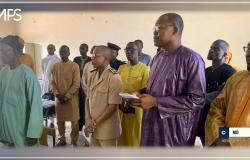In January 2023, the SRF investigation center revealed that the only Nazi monument discovered to date in Switzerland stood in the middle of the Graubünden capital. The municipality of Chur has since undertaken the installation of an information panel. But the latter avoids critical questions and downplays the memorial’s connection with National Socialism, say politicians and historians.
The desire to inform the population emerged a year ago, when SRF has made public the existence of a Nazi memorial in Chur. Today, the results are ambivalent. Historians and members of the Chur Municipal Council criticize the explanatory panel proposed (but not yet installed) by the authorities in the Daleu cemetery, next to the Nazi memorial. According to them, it would be incomplete and lack methodological independence.
Tino Schneider (Centre/GR), municipal councilor in Chur and deputy of the Grand Council of Graubünden, declared in mid-April in the municipal parliament of Chur that “the information panel avoids practically all critical questions.”
Not only, he explains, is missing a chapter on National Socialism in Chur, but the committee in charge of its development also remains silent on a central question: “What did the Chur authorities know at the time, and how did they behave towards the National Socialists?”
The Nazi context minimized
SRF presented the text of the information panel (available in a city communication) to the historian Martin Bucher, who studies the history of National Socialism in Switzerland. He confirms that the text remains vague on many points: “This gives the impression that the City of Chur wants to trivialize the monument’s link with National Socialism.”
For example, the introduction mentions an “anonymous” German institution that had the monument built. Historian Martin Bucher criticizes the fact that only at the end of the long text does it become clear that the client – the “German War Graves Commission” – was a decidedly National Socialist organization.
The role of the authorities of the time and the use of the monument during celebrations of the Third Reich are also excluded from the panel. As SRF reported this a year agofuneral wreaths with swastikas were placed at the cemetery in 1938. At the time, the monument made it possible to celebrate the German soldiers of the First World War in a “hero cult” with which the Nazis intended to legitimize the war.
No independent research
Votes critical of the sign in Chur’s municipal parliament in mid-April had no effect. Chur Mayor Urs Marti (PLR/GR) rejected any changes to the information panel. The reason: it is not up to politicians to judge the history of this era. This is the task of historians. “The city government will not correct the picture,” he defended. Parliament followed suit and approved the information panel in its unchanged form.
City government won’t fix sign
When questioned, the mayor said that the text had been drawn up on behalf of the government by former municipal archivist Ulf Wendler. The content was checked and approved by the State Archivist of Graubünden Reto Weiss and Andrea Kauer, the former director of the Rätisches Museum.
Internal clarification does not meet the criteria of factual and independent historical research
Interviewed by SRF, Sacha Zala, president of the Swiss Historical Society, criticizes this approach. For him, “such internal clarification does not meet the criteria of factual and independent historical research.”
External content
This external content cannot be displayed because it may collect personal data. To view this content you must authorize the category Third Party Services.
Accept More information
No matter the quality of this “internal” research, “one always suspects that in addition to scientific criteria, political considerations also played a role,” he believes. As with controversial legal issues, it is also crucial for historical investigations that independent external research is commissioned. An examination by another authority is not enough, defends the historian.
The approach adopted by the City of Chur prevents politics from playing an active role in the historiography
Mayor Urs Marti replies that he trusts his employees. The investigation carried out by the canton respected the principle of double control. The procedure of the City of Chur certainly carries a risk that certain aspects are less highlighted, “but conversely, the procedure of the city protects against the fact that politics takes an active role in the writing of the history”.
A young Nazi lies in the monument
A year ago, the government and parliament in Chur decided not to continue historical research. The municipality said in a report that the history of the monument had already been the subject of “in-depth” examination. “It is unlikely that further research will provide new information on the history of National Socialism in Chur,” explained the municipality in a report in May 2023.
However, during his investigations, historian Martin Bucher discovered a piquant detail: a young National Socialist is also buried in the monument. Hans Joachim Bunzel, 19, died in 1946, was buried in the Daleu cemetery and then reburied in the memorial, according to the information text. According to a Federal Council report from 1946, Bunzel was a member of the NSDAP, leader of the Hitler Youth and “dangerous because of his Nazi fanaticism.” This is missing from the information panel.

The point of contention: Nazi aesthetics
The question of what to see in the monument is also controversial. The information board should state that the monument does not display any clear National Socialist symbolism. The National Socialist context would therefore not be easily recognizable. This is the position held by the City.
The monument has a brutality that truly represents National Socialism
“They made it too easy for themselves,” says German information designer Andreas Koop, author of a reference work on the appearance of National Socialism. “Something is not just National Socialist if it has a swastika on it,” he explains.
In terms of general appearance, Andreas Koop speaks of a “foreign version of National Socialism”. The theatricality and dramaturgy of this mini-mausoleum are “remarkable”: “The monument has a brutality that truly represents National Socialism.”

According to Andreas Koop, the typography of the inscription “German soldiers lie here” is “Gothic Grotesk”. This font family was developed by designers in Nazi Germany starting in 1933. Such fonts were commonplace at the time. But after the Second World War, this typography was hardly used anymore, because it was considered National Socialist.
Disappointment in Chur City Council
A year ago, Tino Schneider (Le Center/GR) imposed the Nazi stone on the political scene in the city of Chur. Today, he is disappointed with the result. “You go through your own history with blinders on,” he believes, targeting the municipal authorities.
It is still unclear when the information board will be installed.
Stefanie Hablützel (SRF)
Adaptation: Julien Furrer (RTS)









